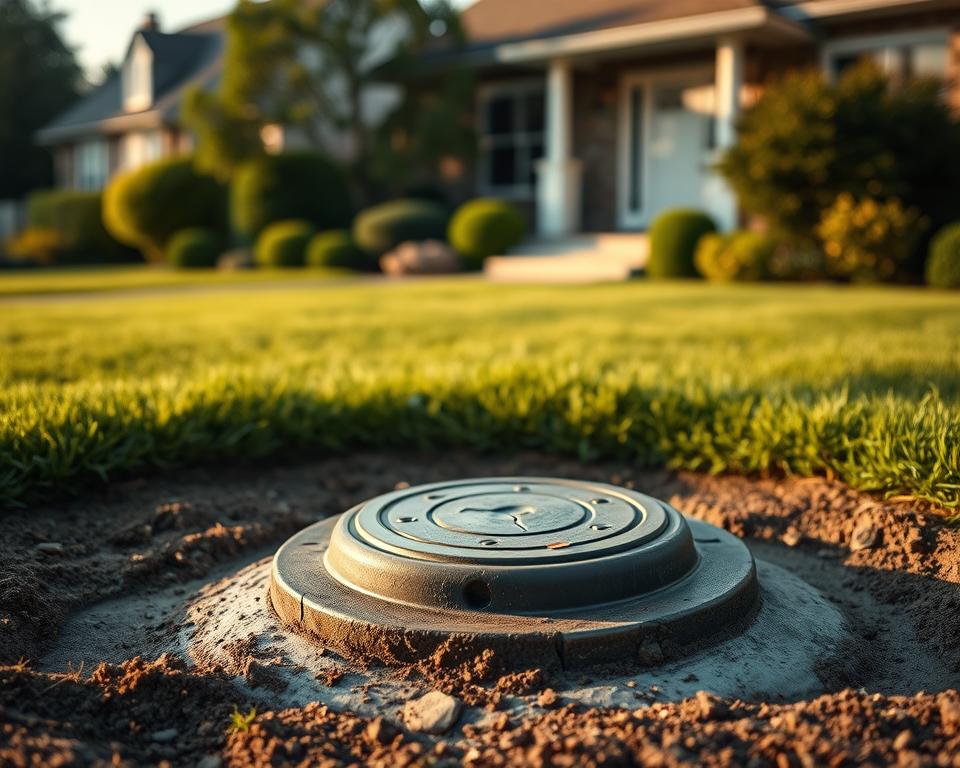Septic Tank Pumping Price Breakdown
Have you wondered about the actual cost of maintaining your septic system up to date, or if you’re paying too much? It’s critical for property owners to understand the particulars of septic tank pumping prices. Generally, the price tag sits near $420, though it can vary considerably. This variance stems from elements like your system’s volume and geographic area – septic tank inspection cost.
Routine upkeep of your septic tank prevents hefty fixes, highlighting the value of knowing service costs. We aim to dive into septic tank service pricing thoroughly. This will help you plan cost‑effectively for your system’s maintenance.
Main Points
- Average septic tank pumping costs about $420.
- Prices can fall between $290 and $560 subject to various factors.
- Regular upkeep prevents more expensive repairs down the line.
- Most households require pumping every 3–5 years.
- Household size and use can influence pumping schedule.
Grasping the Importance of Septic Tank Pumping
Septic tank pumping is crucial for a smooth‑running sewage system. It extracts solids that, if not addressed, create blockages. Consistent pumping doesn’t just prevents bad smells but also fends off high repair costs.
Ignoring septic tank maintenance can threaten our wide use on these systems. Fortunately, affordable services reduce the risk of system failure. Routine upkeep prolongs your septic system’s life, ensuring efficient operation.
Pricing for septic tank upkeep illustrates the value of proactive care. Maintenance detects problems at an initial stage, avoiding severe damage and hefty repair bills. Regular pumping is a smart move for homeowners to secure their asset and ensure peace of mind.
Average Costs for Septic Tank Pumping
Septic tank pumping typically comes between $250 and $600 USD in cost. In most cases, homeowners will spend about $400 USD for this necessary service. Cost swings are attributed to variables like capacity, property location, and how often maintenance is performed. Common tanks, around 1,000 gallons, usually cost between $225 USD and $400.
Homeowners should recognize the importance of budgeting funds every 3–5 years for septic tank cleaning. This regular care depends on the tank’s usage and size. It prevents larger, pricier issues down the road, showing to be both labor and money‑efficient.

Elements Shaping Septic Tank Pumping Prices
Several variables are important in establishing the price of septic tank pumping. Knowing these details helps homeowners to allocate funds for these essential services effectively.
The capacity is significant greatly. Higher‑capacity tanks take more labor and resources to empty, which translates into elevated fees. The ease of access to your tank also greatly affects the price. Tanks buried deep or in difficult locations demand more time and extra gear from technicians, thus boosting the labor costs.
Costs can swing widely according to where you live. This is due to variations in local labor rates and dumping charges. For example, some areas have higher charges for getting rid of waste, influencing the overall service cost. Moreover, tanks with significant solid waste accumulation also attract additional fees—anywhere from $100 to $300 USD. Plus, the more frequently a tank requires pumping—due to higher water usage—the higher the ongoing expenses.
Septic Tank Size and Its Influence on Cost
The volume of your septic tank strongly influences the cost of its upkeep. Compact tanks, for example, those that can hold 750 gallons, tend to have lower pumping costs, commonly ranging from $175 to $300 USD. On the other hand, higher‑capacity tanks, capable of holding up to one thousand seven hundred fifty gallons, may incur charges between $400 and $700. The majority of single‑family residences feature tanks that hold between 1,000 to twelve‑fifty gallons, providing a mix between size and efficiency.
Homes with smaller tanks or many residents often need more frequent pumping services, which increases the overall expense. It’s important to conduct regular septic tank inspections in these situations. This guarantees the tank does not overflow or malfunction, which helps avoid additional costs. By comprehending the connection between tank size and service fees, homeowners can make knowledgeable choices regarding their septic systems and their upkeep requirements.
Regional Differences in Septic Tank Pumping Costs
Septic tank pumping costs can differ substantially based on area. In urban areas, the expenses are often higher due to local septic services having increased overhead. For example, Minneapolis, MN residents may spend between $180 and $280 USD, while those in Portland, OR could see prices from $440 to $750.
The reasons behind these disparities are many. They include regional expenses, demand for septic specialists, and local regulations. In places where septic services are limited, homeowners might pay more due to the service scarcity. Moreover, tough regulations in some regions can increase the need for higher compliance fees, influencing the cost of services.
Being knowledgeable about these geographic cost variances is important for homeowners. It enables them to forecast their septic maintenance spending more realistically. By understanding local pricing, they can seek quotes from specialists wisely, servicing their septic system effectively without overspending.
Additional Costs to Consider with Septic Tank Pumping
Homeowners often forget about various additional maintenance costs connected with septic tank pumping. The primary cost covers just the basic service, excluding other potential expenses. Understanding these can aid in preparing a comprehensive budget.
CCTV inspections, for instance, run between $250 to $500 USD. They offer a non‑invasive look into the system’s condition. Additionally, filter maintenance, which if skipped can create system failures, represents another cost.
The range for repairs can be wide, from $100 to $4,000, depending on the specific issues. This spread highlights the importance of factoring in additional maintenance costs for future budgeting.
Budgeting for Septic Tank Maintenance
When setting funds aside for septic tank upkeep, it’s critical to take a holistic view. This covers multiple critical elements. Owing to variable factors, the cost of maintenance can vary considerably. Hence, effective financial planning is key.
To make sure your system operates efficiently and to avoid unforeseen bills, keep these periods and services in mind:
- Routine pumping: This service is typically required every 3–5 years.
- Inspections: Plan for around $250 USD to $1,180 USD for inspections every three years.
- Potential repairs: Reserve a fund for emergency repairs, which can pop up unexpectedly.
Setting up a regular maintenance calendar with a trusted septic service is key. By forecasting these expenses, homeowners can sidestep the steep costs tied to neglect. This method ensures the life span and efficiency of their septic systems.
Typical Indicators That Your Septic Tank Needs Pumping
Keeping watch to your septic system’s condition is vital. Spot the early signs that suggest your septic tank is due for pumping. Doing so can prevent significant damage and reduce repair costs.
- Slow drains: Water with sluggish flow in sinks, tubs, or toilets could signal your septic tank is overflowing.
- Unpleasant odors: Bad smells around the septic tank or in your yard are frequently urgent signs of a problem.
- Gurgling sounds: Unusual gurgling from your plumbing might suggest air is trapped because of a blockage.
- Wet spots: Soggy areas or greener grass sections near the drain field suggest waste seepage from the tank.
- Dark green grass: Grass that is deeper green and seems healthier around the drain field may point out leakage of nutrients, hinting at an issue.
Scheduled checks by septic system professionals can maintain your tank is in good shape. Using skilled septic technicians for maintenance stops these issues, ensuring your system’s longevity.
Benefits of Consistent Septic Tank Inspections
Scheduled inspections are key to preserving your septic system in excellent order. They identify potential problems before they grow into expensive repairs. By bringing in professionals for these checks, every part of your system receives a thorough assessment.
The inspection looks at several parts of your system, including waste levels and the drain field’s status. It verifies that critical parts, like baffles, function as they should. Spotting issues sooner avoids dangerous overflows and safeguards the environment, helping both your home and the wider community.
Having your septic tank checked every three years can cut a lot of money. It avoids bigger issues from occurring due to neglect. This not only lowers on repair costs but also gives your peace of mind.
| Inspection Aspect | Importance |
|---|---|
| Waste Level Assessment | Prevents overflow and backups |
| Drain Field Evaluation | Identifies saturation and function |
| Component Functionality Check | Ensures proper system operation |
| Early Problem Detection | Saves on repair costs |
Ways to Reduce Spending on Septic Tank Pumping Prices
Homeowners aiming to lower septic tank pumping costs have a few strategic options. Organizing group services with neighbors is one smart method. This involves working together with others nearby to schedule services collectively, potentially securing group discounts. It’s a way to build community bonds while controlling expenses more economically.
Another useful approach is to join maintenance plans with septic service providers. These plans often provide reduced rates for routine check‑ups and pumpings, ensuring septic systems operating properly at a lower cost. Homeowners are advised to ask about these plans when contacting service companies.
Keeping the septic tank easy to reach can also lower pumping expenses. Simple accessibility means there’s less chance of extra labor charges. It’s important to keep the area around the tank unblocked, allowing for straightforward servicing.
Embracing certain habits helps in extending the time between pumpings as well. Cutting back on water usage and limiting garbage disposal use are key practices. These actions can significantly boost septic system health, reducing the need for regular maintenance. By embracing these habits, homeowners can effectively reduce their septic tank pumping costs, protecting their budgets and systems.
Final Remarks
Making sure routine septic tank pumping is essential for homeowners who want to keep their waste management system healthy and in top shape. Being informed about the costs involved permits accurate budgeting. This way, you can find cost‑effective septic services without sacrificing your system’s functionality.
Taking a preventive approach to maintenance is very rewarding. By looking out for clues that indicate the need for pumping, you can avoid costly repairs and lengthen your system’s lifespan. Such actions not only boost your home’s functionality but also offer you peace of mind.
In conclusion, staying on top of routine inspections and timely septic tank pumping is critical for efficient home maintenance. By giving importance to proper planning and choosing affordable septic service, you’ll guarantee your septic system remains working and efficient for many years.
